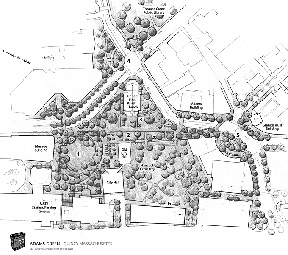When Thomas Koch, mayor of Quincy, announced in January the selection of landscape architects to develop a schematic design for Adams Green, the open space lynchpin for downtown Quincy's sweeping redevelopment, he and the park's designers, Boston-based Halvorson Design Partnership, pledged to create a broad community consensus for this transformative project. Following through on this commitment, Halvorson Design and the mayor's team at city hall have come up with a spectacular vision for the park and its surroundings.
The selection and work of the landscape architect was made possible through a Request for Qualifications process funded by a State Transportation Oriented Development grant of $50,000 won by the Quincy Planning Department in fall of 2009.
Halvorson Design Partnership is one of New England's leading landscape architecture firms, whose major commissions include Boston's Post Office Square Park and South Boston Maritime Park, Center City Park in Greensboro, N.C., the Federal Reserve Bank Plaza in Boston and extensive planning and design work at the historic Mount Auburn Cemetery.
Adams Green and its associated public improvements will return to Quincy Center some of the qualities that existed here centuries ago, when the town's Training Field stood adjacent to the United First Parish Church. But the park will be unmistakably contemporary as well, creating a vibrant, convivial public place and a truly superior pedestrian environment that encourages walking and using transit.
The concept design plans were roundly endorsed at a public meeting in city hall on June 9, following development of many alternative schemes and extensive input from community stakeholders, municipal officials and members of the general public. Craig Halvorson, FASLA, founding principal, and Robert Uhlig, ASLA, president, led the project team at Halvorson Design. Additional traffic analysis was also conducted by the Halvorson team, with traffic engineers Howard Stein Hudson working closely with city departments.
Quincy's forward-looking planning has set the stage for this important new addition to the city's civic realm, beginning with the comprehensive, community-based downtown vision, framework and strategy produced in 2006.
A major element of renewed downtown infrastructure proposed in the vision plan is the Quincy Center Concourse, a new east-west connector route (now under construction) that will tie together the Quincy downtown area, long separated by the north-south subway and commuter rail corridor that provides service to and through Quincy Center. Of equal importance, the Concourse connector road, which skirts the edge of the city center, will allow through traffic to be removed from the local streets, enhancing access for downtown uses.
As we have reported before, the private sector has responded enthusiastically to the growing potential of Quincy Center. The sweeping $1.2 billion redevelopment project, being undertaken by StreetWorks LLC from White Plains N.Y. under agreement with the city will transform downtown Quincy into a vibrant, attractive urban center with new sidewalks, public parks, new retailers, and additional parking. The plan calls for more than 680,000 s/f of offices; 590,000 s/f of retail; and more than 1,100 new apartments and condominiums, five consumer-oriented garages - all four or five stories each. StreetWorks also anticipates a wellness center featuring a gym and medical facilities as well as a permanent downtown home for Quincy College.
The downtown development project is to be anchored by new and renovated office buildings, including a new building along Hancock St. that could reach 20 stories. The project envisions one or two new hotels. The downtown area would feature sidewalk level retail stores and restaurants, and the sidewalks would be widened to between 18 and 20 ft. in order to accommodate open cafes. The entire downtown area will be lined with mature trees
The Adams Green Schematic Design
A. Major Internal Components
1. Town Green/City Hall Plaza
The largest gathering space in the park will be the new "town green." It is located between the entrance to the Quincy Center Red Line/Commuter Rail station, old and new city halls and the point at which Hancock St. will curve into Washington St. A large oval lawn will extend across the space then gently slope up to the level of the T station entrance. Major pedestrian paths will provide access around the lawn to surrounding buildings and a new major crosswalk aligned with the public library
2. Promenade
The former surface of Hancock St. will be replaced by two adjacent straight pedestrian paths, separated by a series of grassy rectangles. This "promenade" corridor will be lined with trees, flowering plants and benches, and will provide safe and convenient access to three of the city's most important historic sites: United First Parish Church, old city hall and historic Hancock Cemetery.
3. First Parish Church Yard
The United First Parish Church (Unitarian Universalist) was the congregation to which Presidents John Adams and John Quincy Adams and their wives, Abigail and Louisa, belonged. The tombs of both presidents and their wives are located in the basement of the church as well. The park design will define the area of the churchyard and facilitate universal access and ceremonial uses, as the church continues as an active place of worship.
B. Major Transition Areas
In order to maximize the positive impact of this new open space, the Adams Green Schematic Design plans also address points of pedestrian access into and out of the park.
4. Coddington/Washington St. Gateway
The x-shaped crossroads formed by Washington St. and Coddington St. is a critical intersection which already has a significant public space on the northeast corner occupied by the library grounds. The park design recommends creation of plaza/open space on the northwest corner, a particularly important location, because school students regularly pass through the area here. A planted median area down the middle of this section of Washington St. is also proposed to enhance the pedestrian scale of the roadway.
5. The Square
At the southern end of Adams Green, across from the striking Art Deco architecture of the Granite Trust Building, the schematic plans show the creation of widened sidewalks and a pedestrian plaza to create a "sense of place" in the downtown for this location where five streets converge. This important location is also the point of connection between Adams Green and the $1.2 billion urban redevelopment project. The concepts for this area have been developed by Halvorson Design, the park's landscape architects, in consultation with StreetWorks,
6. Hancock Cemetery/Burgin Parkway
Increasing access to historic Hancock Cemetery is a primary object of this project, as is improving access along the edge of the railroad tracks from Quincy Center Station along the rear of new city hall and the west side of the cemetery to Granite St. The plans also explore the potential to provide bridge access across the tracks from Burgin Pkwy. and the neighborhood to the west of city hall and the rest of Adams Green.
All in all, the design unveiled by Halvorson Design is a major step toward realizing the imaginative future that Quincy has charted for its historic downtown.
Dean Rizzo is executive director of Quincy 2000 Collaborative, Quincy, Mass. Christopher Green, senior associate from Halvorson Design Partnership, Boston, Mass. contributed to this story.
Tags:









